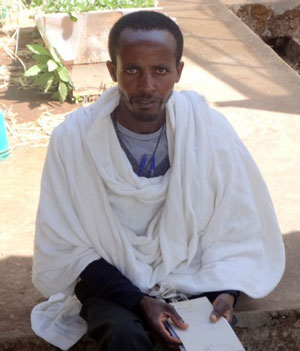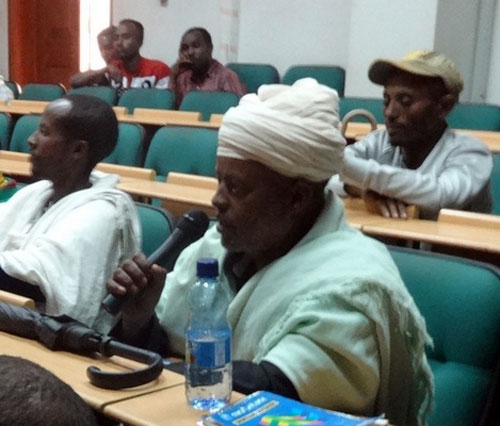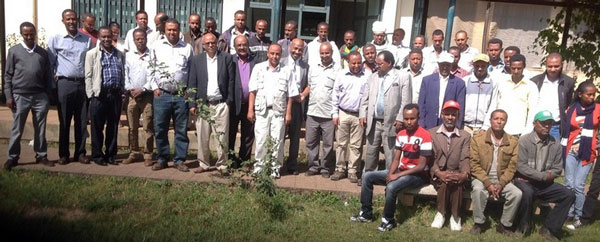“Only those of us bold enough to try conservation agriculture technologies like zero tillage and intercropping benefited a lot, while all others were left behind.” – Hunegnaw Wubie, farmer, South Achefer District, Amhara Region, North Ethiopia
As the curtain comes down on CIMMYT’s Conservation Agriculture and Smallholder Farmers in East and Southern Africa (CASFESA) pilot project, participating farmers in project demonstration sites have said that conservation agriculture (CA) practices have proven to be a viable means of improving their productivity and livelihoods, and need to be scaled up across the nation.

The farmers made these remarks at a one-day workshop on February 23, 2015, convened to take stock of the CASFESA experience after three years of implementation in South Achefer and Jebitehnan Districts of Amhara Region, Northern Ethiopia. The project began in June 2012 and will end in March 2015. Funded by the European Union through the International Fund for Agricultural Development, CASFESA aimed at increasing food security and incomes of poor smallholder farmers through sustainable intensification of mixed, cereal-based systems.
The project will leave a rich legacy, including:
- adaptation and demonstration of CA-based technologies on selected farmer plots;
- enhancing pro-poor and gender-sensitive targeting of CA-based interventions;
- improving the delivery of information, including on technologies and market opportunities to smallholders, as well as developing policy options and recommendations that favor these technologies; and,
- enhancing the capacity of research, and development interventions, for project stakeholders.
Attending the project closing workshop at the Amhara Region Agricultural Research Institute, Bahir Dar, in northwestern Ethiopia, were Regional Bureau of Agriculture officials; Directors of the Ministry of Agriculture Extension Process and the Ethiopian Agricultural Transformation Agency’s Climate and Environmental Sustainability Program; agronomists; representatives of relevant governmental and non-governmental and research organizations; and, above all, farmers. Keynote presentations included The Economic and Environmental Benefits of Sustainable Intensification Practices by Dr. Menale Kassie, while Dr. Mulugetta Mekuria and Mr. Yeshitla Merene presented the experience and research results from the Sustainable Intensification of Maize–Legume Cropping Systems for Food Security in Eastern and Southern Africa (SIMLESA).
Reaping where you do not harrow
Farmers spoke passionately on how CA technologies proved profitable for them and their families “in beating the odds”. Most reported harvests of six or more tonnes per hectare of maize from the CA plots – relatively better harvests than with conventional plowing methods, plus the added benefits of reduced use of oxen and labor, and attendant advantages. They also called upon officials responsible to undertake corresponding measures to ensure that CA technologies are sustainably implemented and adopted on a wider scale.
One of these ‘farmer-researchers’, clergyman Enkuhanhone Alayu, narrated how people at first ridiculed him when, three years ago, he volunteered to demonstrate CA practices on his meagre plot of land. They laughed at him “for expecting to cultivate crops without plowing” – a reference to minimum tillage practices that the project advocates as a central element of conservation agriculture.
“But when they later saw that we were cultivating more quantity of maize per unit of land, they were surprised and people who had called me a fool began calling me even at night seeking advice on how they can replicate CA practices on their plots and gain the benefits,” Alayu said. “Zero tillage practices, which require considerably less labor, are even more relevant at this time when oxen are increasingly becoming very expensive and most farmers are not able to afford them.”

Unto the next generation…
Another farmer, Ato Hunegnaw Wubie, said he was so pleased with CA technologies that he also taught his children how to do it on a portion of his land allotted to each of them. “One of my six children was so successful that this year he was able to reap 66 kilos of maize from a 10 by 10 meter plot. He sold his harvest at the market, and, with some additional money from me, bought a bicycle that he uses for transport to and from school. Only those steadfast enough and willing to learn new things will reap the benefits from such novel practices,” he added with pride.
And the farmers were not alone. Speaking at the workshop, the Deputy Head of Amhara Region Bureau of Agriculture, Dr. Demeke Atilaw, noted that maize production in the region stands at a meagre 3.2 tonnes per hectare, and that one reason for this is that “our agricultural practices didn’t include conservation agriculture. This needs to change both at the regional and national levels.” He further pledged that the bureau will work towards sustainably implementing these technologies with a view to increasing maize yields to eight tonnes per hectare.
Roadmap to national goals: “… projects alone cannot bring about significant change…”
In addition to CASFESA, CA technologies are being implemented in the region by SIMLESA, a CIMMYT project in Ethiopia, as well as in Kenya, Malawi, Mozambique and Tanzania. Presenting the experience of SIMLESA thus far, project leader, Dr. Mekuria told the participants that “the experience of both these CIMMYT projects, promising as they are, cannot alone bring about significant change unless they are scaled out using more new varieties of maize and sustained through meaningful institutional involvement – especially that of agencies at all levels of government.”
CIMMYT Agricultural Economist and CASFESA project coordinator, Dr. Moti Jaleta, also said that the experience of CASFESA has demonstrated that CA technologies are economically viable and thus worth pursuing on a wider scale and in a sustainable way. He particularly commended those farmers who volunteered to provide portions of their land as demonstration plots for CA technologies. “Their efforts and dedication have now paid off,” he noted, adding that project end does not mean that CASFESA will leave precipitously: there are still monitoring and evaluation and other wind-up tasks before project exit.

The Deputy Director General of the Amhara Regional Agricultural Research Institute, Dr. Tilaye Teklewold, summed up the mood of the day when he said that CASFESA’s experience in Amhara Region has shown that conservation agriculture is an ideal way of increasing the productivity of maize in the region, and that “concerted efforts are needed to raise the awareness and dedication of all actors involved in the region to implement these technologies and ensure lasting food security in the region and beyond.”
Links
- Presentations at the workshop
- CASFESA Project: Results, Lessons, Gaps, Opportunities and Challenges in English | Amharic
- Economic and Environmental Benefits of Sustainable Intensification Practices
- Progress and Achievements of SIMLESA project in Amhara Region
- SIMLESA: Enhancing Integration, Innovation and Impacts in Eastern and Southern Africa – Initial Findings and Lessons
- More on conservation agriculture at CIMMYT
 Innovations
Innovations